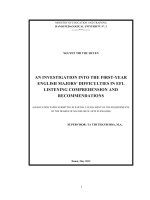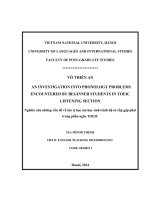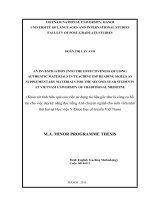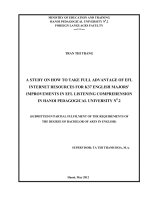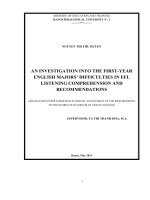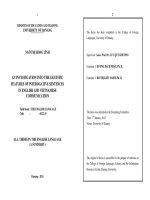An investigation into the first year english majors difficulties in efl listening comprehension and recommendations
Bạn đang xem bản rút gọn của tài liệu. Xem và tải ngay bản đầy đủ của tài liệu tại đây (599.41 KB, 76 trang )
MINISTRY OF EDUCATION AND TRAINING
HANOI PEDAGOGICAL UNIVERSITY Nº. 2
=====***=====
NGUYEN THI THU HUYEN
AN INVESTIGATION INTO THE FIRST-YEAR
ENGLISH MAJORS’ DIFFICULTIES IN EFL
LISTENING COMPREHENSION AND
RECOMMENDATIONS
(GRADUATION PAPER SUBMITTED IN PARTIAL FULFILLMENT OF THE REQUIREMENTS
OF THE DEGREE OF BACHELOR OF ARTS IN ENGLISH)
SUPERVISOR: TA THI THANH HOA, M.A.
Hanoi, May 2013
i
ACKNOWLEDGEMENTS
For the completion of this thesis, I have received great assistance and support
from many people without whom the work could not have been fulfilled.
First and foremost, I would like to express my sincere thanks to Mrs. Ta Thi
Thanh Hoa, M.A., my supervisor. This thesis could have probably not completed
without her patient, enthusiastic and instructive supervision and encouragement.
I also would like to show my profound gratitude to all the lecturers at Hanoi
Hanoi Pedagogical University N0.2, especially the lecturers in the Foreign
Language Faculty for tirelessly devoting time and efforts to enrich, broaden and
deepen my knowledge over the past four years.
My special thanks go as well as to the Foreign Languages Department of
Hanoi Pedagogical University N0.2 for giving me the opportunity and permission
to implement this report.
I am particularly grateful to the first-year English majors coming from course
38 of Foreign Language Faculty, Hanoi Pedagogical University N0.2 who help me
a lot in completing the survey so that I can get the data for my research.
I cannot help fully expressing my gratitude to all people that direct and
indirect support me to accomplish my thesis in time. My thesis may still have
many shortcomings.
Last but not least, I owe a debt of gratitude to my beloved family, for their
whole-hearted encouragement and endless support.
ii
ABSTRACT
Listening skill is one of the most important skills to the learners of
English. Apart from speaking skill, listening is key skill used in communication.
Therefore, it is a compulsory subject for the first three-year English majors at
Hanoi Pedagogical University N0.2 (HPU2).
However, listening comprehension has been considered the most difficult of
the four language skills. It requires a long training process. As a result, many
English majors have problems in listening comprehension, especially the first-year
students. It is often harder for the beginners to listen because they lack of
experience and don’t have appropriate learning methods. Therefore, this research
entails studying difficulties in learning to listen to English faced by students as
well as causes of these difficulties and conducting a survey for the reasons. Based
on the results of the survey, the difficulties and causes have been found. Solutions
to the problems have been suggested.
It is hoped that this study will make contribution to solving some of the
existing problems of inadequate listening competence of the English majors at
HPU2.
iii
STATEMENT OF AUTHORSHIP
Title: An investigation into the first-year English majors’ difficulties in EFL
listening comprehension and recommendations
(Graduation paper submitted in partial fulfillment of
The Degree of Bachelor of Arts in English)
I certify that no part of this research has been copied or reproduced from any
other person’s work without acknowledgements and that the report is originally
written by me under strict guidance from my supervisor.
Dated submitted: May 2013
Student
Supervisor
Nguyen Thi Thu Huyen
Ta Thi Thanh Hoa, M.A.
iv
LIST OF TABLES
Table 1: Students’ listening activities in classroom
Table 2: Students’ pre-listening activities
Table 3: Students’ ways to deal with new words
Table 4: Problems from listeners
Table 5: Problems from listening materials
Table 6: Listening strategies to English of students at HPU2
Table 7: Students' expectation of their teachers' teaching techniques
LIST OF CHARTS
Chart 1 and 2: Students’ attitudes towards listening skill
Chart 3: Students’ pronunciation in listening
Chart 4: Students’ attitudes towards speed of speakers
Pie chart 1: Students’ habits of learning to listen outside class
Pie chart 2: Students’ while listening activities
Pie chart 3: Students' post-listening activities
Pie chart 4: Students' vocabulary in listening
Pie chart 5: Students' attitudes towards unfamiliar and various accents
Pie chart 6: Effect of hesitation on students in listening
Pie chart 7: Effect of features of spoken language on listening
Pie chart 8: Students' attitudes towards noise in listening
v
LIST OF ABBREVIATION
HPU2: Hanoi Pedagogical University Number 2
EFL: English as Foreign Language
vi
TABLE OF CONTENTS
ACKNOWLEDGEMENTS .................................................................................... i
ABSTRACT.......................................................................................................... iii
STATEMENT OF AUTHORSHIP ....................................................................... iv
TABLE OF CONTENTS ...................................................................................... vi
PART ONE: INTRODUCTION............................................................................. 1
I. RATIONALE .................................................................................................. 1
II. RESEARCH PRESUPPOSITION .................................................................. 2
III. RESEARCH OBJECTIVES.......................................................................... 2
IV. RESEARCH SCOPE .................................................................................... 3
V. RESEARCH TASKS ..................................................................................... 3
VI. RESEARCH METHODS ............................................................................. 3
VII. SIGNIFICANCE OF THE PROPOSED RESEARCH................................. 4
VIII. DESIGN OF THE RESEARCH WORK .................................................... 4
PART TWO: DEVELOPMENT ............................................................................ 6
CHAPTER ONE: THEORETICAL BACKGROUND ........................................... 6
1.1. Literature review in brief.............................................................................. 6
1.2. Theoretical background of listening comprehension .................................... 7
1.2.1. The general concepts of listening comprehension .................................. 7
1.2.2. Classification of listening comprehension .............................................. 9
1.2.2.1. Real-life listening .......................................................................... 10
1.2.2.1.1. Casual listening ....................................................................... 11
1.2.2.1.2. Focused listening..................................................................... 12
1.2.2.2. Classroom listening ....................................................................... 12
1.2.2.2.1. Intensive listening ................................................................... 12
1.2.2.2.2. Extensive listening .................................................................. 12
1.2.3. Process of listening comprehension ..................................................... 13
1.2.3.1. Bottom-up processing .................................................................... 13
1.2.3.2. Top-down processing .................................................................... 14
1.2.3.3. Interactive processing .................................................................... 14
1.2.4. Factors affecting listening comprehension ........................................... 15
1.2.4.1. The listeners .................................................................................. 16
1.2.4.1.1 The listeners’ background knowledge ...................................... 16
vii
1.2.4.1.2. The listeners’ linguistic knowledge. ........................................ 17
1.2.4.1.3. Listeners’ ability to concentrate............................................... 18
1.2.4.2. The speakers .................................................................................. 18
1.2.4.2.1. Different accents ..................................................................... 18
1.2.4.2.2. Speed of speakers .................................................................... 19
1.2.4.2.3. Hesitations .............................................................................. 19
1.2.4.3. Listening materials ..................................................................... 19
1.2.4.4. Physical settings ............................................................................ 20
1.2.4.5. Features of spoken language....................................................... 20
1.2.5. Students’ listening activities ................................................................ 21
1.2.5.1. Students’ activities in pre-listening stage ....................................... 21
1.2.5.2. Students’ activities in while-listening stage ................................... 22
1.2.5.3. Students’ activities in post-listening stage ..................................... 23
1.2.6. Potential problems in learning to listen to English ............................... 24
CHAPTER TWO: INVESTIGATION INTO COMMON PROBLEMS OF
LISTENING COMPREHENSION....................................................................... 26
2.1. Survey........................................................................................................ 26
2.1.1. Purpose of the survey........................................................................... 26
2.1.2. Participants .......................................................................................... 26
2.1.3. Setting of the survey ............................................................................ 27
2.1.4. Type of the survey ............................................................................... 27
2.1.5. Administration of the try-out
2.1.5.1. Preparations of the try-out
2.1.5.2. Try-out
2.1.6. Research methods. ............................................................................... 28
2.1.6.1. Data collection instruments ........................................................... 28
2.1.6.2. Data analysis methods ................................................................... 28
2.2. Data analysis .............................................................................................. 29
2.2.1. Students’ attitudes towards EFL listening ........................................... 29
2.2.2. Students’ learning habit of listening outside classroom and in classroom
...................................................................................................................... 30
2.2.2.1. Outside classroom ......................................................................... 30
2.2.2.2. In classroom .................................................................................. 31
viii
2.2.3. Students’ activities in three stages of listening: pre, while and post
listening ......................................................................................................... 31
2.2.3.1. Students’ pre –listening activities .................................................. 31
2.2.3.2. Students’ while listening activities................................................. 32
2.2.3.3. Students’ post-listening activities .................................................. 32
2.2.4. Students’ problems in listening comprehension ................................... 33
2.2.4.1. Problems from the listeners ........................................................... 33
2.2.4.2. Problems from the speakers ........................................................... 38
2.2.4.4. Problems from listening materials ................................................. 41
2.2.4.5. Problems from physical settings .................................................... 42
2.2.5. Listening strategies of fresh students at HPU2 ..................................... 43
2.2.6. Students’ expectation of their teachers’ techniques .............................. 43
2.3. Discussion of major findings ...................................................................... 44
2.3.1. Difficulties of the first year majors at HPU2 in learning to listen to
English and causes......................................................................................... 44
2.3.1.1. Students’ limited vocabulary ......................................................... 45
2.3.1.2. Students’ incorrect pronunciation .................................................. 45
2.3.1.3. Lack of control of speaking speed ................................................. 45
2.3.1.4. Listening unfamiliar and different accents ..................................... 46
2.3.1.5. Other problems .............................................................................. 46
CHAPTER THREE: MAJORS SOLUTIONS AND RECOMMENDATIONS TO
IMPROVE STUDENTS’ LISTENING COMPREHENSION .............................. 49
3.1. Improving the students’ linguistic knowledge ............................................ 49
3.1.1. Enriching vocabulary ........................................................................... 49
3.1.2. Improving Pronunciation ..................................................................... 50
3.1.3. Getting used to different accents .......................................................... 51
3.2. Applying listening strategies ...................................................................... 51
3.2.1. Using interactive model
3.2.2. Predicting the content of the spoken text by signals ............................. 52
3.2.3. Identifying main ideas based on signals ............................................... 53
3.2.4. Taking notes of the main ideas ............................................................ 54
3.2.5. Guessing vocabulary based on context................................................. 56
3.2.6. Determining the relationships of ideas ................................................. 57
ix
3.2.7. Mastering the features of spoken language..............................................
PART THREE: CONCLUSION .......................................................................... 59
III.1. The achievement of the study ................................................................... 59
III.2. Limitations of the research ....................................................................... 59
REFERENCES .................................................................................................... 60
x
PART ONE
INTRODUCTION
I. RATIONALE
It cannot be denied that English language in the whole world has become
more and more important. It is considered the international means of
communication in many fields of our life. These days, the English language has
become the global language. It is the mother tongue of many countries over the
world. Besides, a number of countries use it as a second language. In fact, English
is the native language of more than 350 million people and it is spoken more than
any other languages. It is the international language of different fields such as
business, politics, science, technology, banking, tourism and others. Therefore, the
demand for learning English is very great. In Vietnam as well as in other countries,
there is a greater and greater need to learn English, from young to old, and from
male to female alike. It cannot be denied that English plays a vital role in Vietnam
nowadays. Therefore, English is being taught at every educational level. It has
become a compulsory subject in most schools.
In order to acquire good knowledge of English, we must master four basic
language skills namely listening, speaking, reading and writing in which listening
is the most important and challenging skill. Listening plays a crucial role in daily
life. People listen for different purposes such as entertainment, academic purposes
or obtaining necessary information. As for foreign language learning, listening is
of paramount importance since it provides the language input (Rost, 1994).
Without understanding input appropriately, learning simply cannot get any
improvement. Apart from speaking skill, listening is a key skill used in
communication. Listening skill is very important because unless you are able to
hear, you cannot understand what others mean, so you do not know how to reply.
This means that only when you can understand, you can speak. Therefore, without
comprehending spoken input, no communication can be achieved (Cross, 1998).
1
Despite the fact that listening is an important skill, language learners,
especially those who learn English as a foreign language in a non-native setting,
find it difficult to acquire good listening skills. In fact, many learners of English
have difficulties in listening comprehension, especially the first-year students,
which leads them to the poor listening performance. It is harder for the beginners
to listen well because they often lack of experience and have no appropriate
learning methods. Therefore, as a prospective teacher, I would like to make a
contribution to the English teaching in Vietnam. In addition, the research available
on EFL comprehension is still insufficient. Comparing with other skills, there are
fewer insights into the process of listening and the way it is learnt.
For the reasons mentioned above, this study is conducted. The research is an
attempt to identify common problems of learning to listen to English faced by the
first-year English majors at Hanoi Pedagogical University N0.2 as well as to
provide some suggestions with the hope to improve listening skill. Besides, I also
wish to contribute to enriching the listening research which has been done so far.
II. RESEARCH PRESUPPOSITION
Several principle questions are raised as follows:
1) What problems of listening comprehension are most often encountered by
the first-year English majors at Hanoi Pedagogical University N0.2?
2) What are the possible causes of the first-year English majors’ difficulties in
acquiring listening skill?
3) What techniques should students apply in improving the effectiveness of
teaching and learning listening comprehension?
III. RESEARCH OBJECTIVES
The study is aimed at the following goals:
1) To find out the most common difficulties in learning listening comprehension
encountered by the first-year English majors at Hanoi Pedagogical University N0.2 .
2) To identify the causes of the problems of listening comprehension faced by
the first-year English majors at Hanoi Pedagogical University N0.2.
2
3) To provide some suggested solutions to minimize the difficulties and
improve efficiency in listening comprehension.
IV. RESEARCH SCOPE
Within this study, the researcher only focuses on the first-year English majors
at Hanoi Pedagogical University N0.2 to investigate the troubles that students at
this class usually encounter and then give some proposals to overcome discovered
difficulties and to improve students’ listening ability.
The population involved in the study is fifty English majors of Course 38 of Faculty
of Foreign Languages at Hanoi Pedagogical University N0.2.
V. RESEARCH TASKS
The study involves fulfilling the following tasks:
1) To study the definition, process of listening comprehension, classification
of listening comprehension, factors affecting listening comprehension, students’
listening activities as well as potential problems in learning to listen to English.
2) To investigate the most common difficulties in listening comprehension
encountered by the first-year English majors and causes.
3) Based on the major findings, possible suggestions to the problems are
proposed to minimize the student’s difficulties and enhance effectiveness in
listening comprehension.
VI. RESEARCH METHODS
1) Data collection
I have already collected documents from book in library and in the internet to
complete this study. Moreover, some of documentary which my supervisor
introduced and provided are greatly useful for my research.
2) Survey questionnaires
In terms of the methods, the questionnaire is designed as a means for
researcher to collect data. Questionnaires are more amenable to quantification,
cheap and easy to answer. Moreover, questionnaires are considered more reliable
way since they are anonymous and this encourages greater honesty. Questionnaires
included closed and open-ended questions.
3
The questionnaire is given to students of the first-year English majors with the
hope to find out their attitudes towards their listening skill and their difficulties in
listening to English as well as their expectations to their teachers. As they are in their
first academic year, they often experience such problems. It is stage that students
should be equipped with variety of techniques right from their early listening. With
appropriate strategies, they will have built up their listening skill by the time.
3) Data analysis
Based on the results of the survey, data analysis method is also used for the
research. Data gathered from responses of the students to given questionnaires were
sorted and analyzed statistically to get the answers for the given research questions.
VII. SIGNIFICANCE OF THE PROPOSED RESEARCH
Difficulties in any language teaching and learning, particular in English as a
foreign language, are sometimes predictable and sometimes unpredictable. It is,
therefore, essential for teachers to have better treatment to anticipate difficulties.
After the research, it is hoped that the result will be useful:
1) For learners of English, the result of this study helps to work out the
common problems face by fresh students and to provide some ways to overcome
these difficulties and improve their listening skill- one of the most difficult skills.
2) For teachers of English, the findings of this study will give valuable and
useful information on problems and proposals to the problems so that they can
have effective methods of teaching listening comprehension.
This study is also beneficial to anyone who is interested in listening comprehension.
VIII. DESIGN OF THE RESEARCH WORK
The research work has three main parts, namely: Introduction, Development
and Conclusion. The part “Development” consists three chapters.
Chapter 1 is entitled “Theoretical background”. It includes two sections.
Section one presents literature review in brief. The second one deals with things
related to the listening comprehension such as definition, classification, process
and stages in listening comprehension as well as factors affecting the process of
listening comprehension.
4
Chapter 2 is named “An investigation into the first-year English majors’
difficulties in listening comprehension”. It has three sections. Section one is
devoted to the survey which focuses on the methods used to gather and analyze
data and describes the current situation of students at HPU2. The second section
presents data analysis based on the collected results of the survey. The last section
makes discussion of some common problems faced by students and possible causes
of these problems.
Chapter 3 is entitled “Major solutions and recommendations to improve
students’ listening comprehension”. It provides some recommendations for
improvement of the listening comprehension.
5
PART TWO
DEVELOPMENT
CHAPTER ONE
THEORETICAL BACKGROUND
1.1. Literature review in brief
The issues of teaching and learning the listening skill have been of great
concern among a number of researchers. There have been many researchers who
studied listening over the world such as Anderson and Lynch, Mary Underwood,
Flowerdew and Miller, Yagang, Penny Ur, and Hasan and so on. Actually,
listening plays an important role in second language instruction for several reasons
(Rost, 1994). In listening (1988), Anne Anderson and Tony Lynch give an
alternative view of listening: listening is not passive language skill, but active and
the listener acts as active model builder. In the book Language, culture and
cirriculum, Hasan (2000) points out that the learner’s perception of their listening
problems and strategies can affect their comprehension both positively and
negatively. According to Yagang (1994), the problems in listening are
accompanied with the four following factors: the message, the speaker, the listener
and the physical setting. Mary Underwood in Teaching Listening (1989) gives a
clear description of the features of spoken language. In additions, she also
mentions potential problems in learning to listen to English. In Assessing listening,
Gary Buck (2001) mainly focuses his attention on the assessment of listening, it
covers virtually all aspects of second language listening research and aims not only
at language testers, but it is also suitable and accessible to researchers and
language instructors as well. David Nunan in Practical English language teaching:
listening deals with techniques of teaching listening in general and teaching
listening for different learners’ level. In terms of recommendation, in Listening
strategy guide, Michael Berman (2003) introduces some listening strategies to
improve the effectiveness in listening.
The research available on English listening comprehension as the foreign
language is still insufficient. Comparing with other skills, Goh (1997) say that
6
“there are fewer insights into the process of listening and the way it is learnt”.
Similarly, Richard (1985) states that: “there is little direct research on second
language listening comprehension”. As for that, I am doing this research not only to
help students in our university with better listening but also to make a considerable
contribution to enriching the listening research which has been done so far.
1.2. Theoretical background of listening comprehension
In this chapter, I would like to provide a theoretical background to the present
study to help students know more and deeply about the listening comprehension. It
is composed of five sections. The first section presents various ways of defining
listening. The second section is about classification of listening comprehension.
The next section focuses on listening comprehension processing. The fourth
section is designed to look at the factors that make listening difficult. The coming
section mentions students’ activities in three stages of a listening lesson. The last
one deals with potential problems in listening comprehension.
1.2.1. The general concepts of listening comprehension
It is considered that listening comprehension is a fundamental and important
skill in language learning. It is also a significant and essential area of development
in a native language as well as in a foreign language; therefore, there have been
numerous definitions of listening comprehension which present different views of
scholars toward the concept.
There are two influential views: traditional view and alternative view
(Listening, 1988).
Traditional views considered listening, alongside reading skill, as a passive
language skill while speaking and writing were active skills. Learners play a passive
role in the listening learning process. Listeners were thought of as human tape
recorders: they took in a bit of information, stored it in a sort of medium-term
memory and used it in much the same way as a tape recorder. In other words, they
just listen to the messages, record and understand the meaning of the speaker’s
utterances without paying sufficient attention to such factors as context, background
knowledge of the speakers as well as intentions, attitudes, implications and other
7
shades of meaning. For this perception, teaching listening, in the traditional way, is
thought as teaching listening for sounds, not for meaning. Therefore, Anderson and
Lynch criticized “this view represents an inappropriate and inadequate view of the
listening process” (Listening, 1988). This notion is not a tenable one.
Until recently, the view on the concept of listening comprehension has been
changed and replaced with alternative view. However, there exist different points
of view about listening comprehension defined by various researchers.
Alternative view, according to Anderson and Lynch, in contrast with
traditional view, considers the listener as an active model builder. Listening is
really a receptive skill and the role of the listener is no longer passive but active.
Therefore, the role of the successful listeners has to be thought of as an active one.
In the listening process, the listeners keep an important part to play in the process
by activating various types of knowledge and by applying what he knows to what
he hears and trying to understand what the speakers mean. Or in other way, this
kind of listener could combine the new information in what he has just heard with
his previous knowledge and experience to reach full comprehension of what had
been heard (spoken text). Both researchers agreed with this view, which
emphasizes the active interpretation and integration of incoming information with
prior knowledge and experience. Other scholars supported this view as well.
Buck (2001) describes listening comprehension as “Listening comprehension is
an active process of constructing meaning and this is done by applying knowledge to
the incoming sound” in which “number of different types of knowledge are involved:
both linguistic knowledge and non-linguistic knowledge”.
O’Malley and Chamot (1989) make a conclusion that “Listening comprehension
is an active and conscious process in which the listener constructs meaning by using
cues from contextual information and existing knowledge, while relying upon multiple
strategic resources to fulfill the task requirement”.
According to Richards and Schmidt (2002), “Listening comprehension is the
process of understanding speech in a first or second language. The study of listening
comprehension in second language learning focuses on the role of individual linguistic
8
units e.g., phonemes, words, grammatical structures as well as the role of the listener’s
expectation, the situation and context, background knowledge and topic”.
Among the various definitions, a representative one is propounded by Clark
and Clark (1997). They give both a narrow and broad definition. Comprehension
has two common senses. In it narrow sense it denotes the mental process by which
listeners take in the sound uttered by a speaker and use them to construct an
interpretation of what they think the speaker tended to convey…comprehension in
its broad sense, however, rarely ends here, for listeners normally put the
interpretation they have built to work”.
Rubin (1995) gave a quite clear definition of listening comprehension that
“Listening is conceived of as an active process in which listeners select and
interpret information which come from auditory and visual clues in order to define
what is going on and what the speakers are trying to express”.
Listening comprehension becomes an active skill in which learners keep a
positive role of attending in what have been heard, treat, understand and interpret
the information so that they may respond to this information immediately or
remember the message to respond at a later time. This reflects exactly that listening
comprehension process consists of four steps: receiving-understand-assess-respond
in sequence given by Steil, Barker and Wakson (1983). Only when listener can
respond, listening comprehension process is completed.
In conclusion, listening comprehension is not a passive but active and
conscious process in which listeners construct and convey the meaning by using
not only the linguistic clues but also their non-linguistic. Linguistic knowledge is
of different types, containing such important types as phonology, lexis syntax,
semantics and discourse structure. The non-linguistic knowledge used in
comprehension is knowledge about the topic, the situation and context, background
knowledge and experience
1.2.2. Classification of listening comprehension
In the view of Shelagh Rixon (1986), listening can be classified into two
types: real-life listening and classroom listening.
9
1.2.2.1. Real-life listening
Listening plays a fundamental role not only in the classroom but in daily lives
as well. Of course, every day you listen to a variety of different things. Learners
use listening skill in many of situations in real-life for a range of purposes such as
entertainment, academic purposes or obtaining necessary information. Obviously,
there is a big gap between listening activities in the classroom and actual listening
in real-life. Listening materials which is used by learners to study are very
grammatical and controlled speed, with perfect voice tone, accent and correct
grammar. On the other hand, real-life listening refers to real-life conversation
performed by speakers who have different accents, voice tones and speed without
or less paying attention to grammar. The language used in real-life listening is
often colloquial with full of slang or idioms.
In Teaching Listening Comprehension (1992), Penny Ur states that there are
plenty of different types of listening used in real-life situations. Following is a list
of listening types in real-life suggested by Penny Ur:
- Listening to the news/ weather forecast/ sport report...etc on the radio
- Discussing work/ current problems with family or colleagues.
- Making arrangements/ exchange news etc. with acquaintances.
- Chatting at a party
- Attending a lesson/ seminar
- Being interviewed/ interviewing
- Watching a film/ theatre show/ television program
- Hearing a speech/ lecture
- Being tested orally in a subject of a study and so on
According to Penny Ur (1992), “there is a distinction between formal speech or
“spoken prose” and the informal speech use in most spontaneous conversation”. In
his view, informal speech is usually both spontaneous and colloquial in character;
formal speech is characteristically neither. There are some basic differences between
formal speech and informal such as redundancy, noise, colloquial language and
auditory character (Teaching listening comprehension, 1992).
10
Penny Ur also indicates that there is a distinct difference between the auditory
effect of a piece of spoken prose and that of informal conversation. The former is
characterized by a fairly even pace, volume and pitch. Spontaneous conversation,
on the other hand, is jerky, has frequent pauses and overlaps, goes intermittently
faster and slower, louder and softer, higher and lower. Hesitations, interruptions,
exclamations, emotional reactions of surprise, irritation or amusement, which are
liable to occur in natural dialogues, are bound to cause an uneven and constantly
changing rhythm of speech. The overall effect of all this is perhaps more dramatic
and interesting than that of formal speech, but this does not mean that it is, all in
all, more comprehension or easier to listen to.
To summarize, we may say that most but not all of our real-life listening
activity is characterized by the following features:
- We listen for a purpose and with certain expectations
- We make an immediate response to what we hear
- We see the person we are listening to
- There are some visual or environmental clues as to the meaning of what is
heard
- Stretches of heard discourse come in short chunks
-
Most heard discourse is spontaneous and therefore differs from formal
spoken prose in the amount of redundancy, noise and colloquialisms, and in its
auditory character.
Sometimes particular situations may lack one or more of these characteristicswhen watching television we are not normally expected to respond, when listening
to a lecture we may have to hear an uninterrupted speech for a very long time
indeed- but it is only very rarely that none of them is present at all.
According to Adrian Doff (1995), there are two types of real-life listening:
casual listening and focused listening.
1.2.2.1.1. Casual listening
Casual listening refers to listening to something with no particular purpose
and often without much concentration or we are listening to something without
11
some ideas what we are going to hear. In daily life we often meet this kind of
listening such as listening to music while studying or listening to radio television
while we do something else. Thus we may not remember much of what we hear or
there may be nothing in your mind (Adrian, 1995).
1.2.2.1.2. Focused listening
In contrast, focused listening is when we listen to something for a particular
purpose to obtain necessary information. In this case, we often listen with much
attention but we do not listen to everything we hear with equal concentration- we
often listen for the key points or for particular information. (Adrian, 1995)
1.2.2.2. Classroom listening
As suggested by Rixon (1986), there are two types of listening that can be
applied in classroom: intensive listening and extensive listening.
1.2.2.2.1. Intensive listening
Intensive listening is careful and focused listening for detailed information,
for example: listening to the announcement or listening to the weather forecast. In
some cases, intensive listening is very important if listeners want to know some
small details. Intensive listening requires learners to listen with much attention for
specific information or full comprehension which involves finding the answers to
specific questions. This kind of listening helps learners improve their listening skill
to grasp information in detail in their effort to do exercises or other activities. The
passage should be short so that it helps listeners fell easy, interesting and
encouraging. Therefore, they often listen with great concentration.
1.2.2.2.2. Extensive listening
Extensive listening, on the other hand, is listening for general ideas, not for
particular information. This type of listening is often used when listeners just want
to know the key points without paying attention to specific information such as
listening to stories or films. Recognizing the main points of listening helps us
understand the content of the listening. The extensive listening requires listeners to
collect supporting details to find out the main idea. The purpose of extensive
listening is to develop the students’ skill in recognizing main points as well as the
general meaning of spoken text. Differ from intensive listening, extensive listening
12
is an activity in which listeners are not asked to do language work on what they
hear. Therefore these types of listening allow learners to listen for pleasure without
any pressure. Further more, the language used in this sort of listening is often
within the listeners’ current ability so that students find it interesting when
listening and feel satisfied as they understand the passage well. This contributes to
motivating them to enhance their listening skill.
1.2.3. Process of listening comprehension
Besides the controversies over the definition of listening comprehension,
there also exist the concerns about the process of listening comprehension.
Listening comprehension is regarded theoretically as an active process in which
individuals concentrate on selected aspects of aural input, form meaning from
passages, and associate what they hear with existing knowledge.
Considering how the listeners process the input, researchers have classified
listening process into two types: bottom-up process and top-down process
(Flowerdew and Miller, 2005).
1.2.3.1. Bottom-up processing
Bottom-up processing is the text based process in which listeners try to make
sense of what we hear by focusing on the different parts: the vocabulary, the
grammar or functional phrases, sound, etc. (David Nunan, 1999). It is activated by
the new incoming data. The features of the data pass into the system through the
best fitting, bottom-level schemata. Schemata are hierarchically formed the most
specific at the bottom to the most general at the top. It acknowledges that listening
is a process of decoding the sounds, from the smallest meaningful units
(phonemes) to complete texts. Thus, phonemic units are decoded to construct
phrases; phrases are connected to construct complete, meaningful text. That is to
say, meaning is arrived at as the last step in the process. A chain of incoming
sounds trigger schemata hierarchically organized in a listener’s mind- the
phonological knowledge, the morphological knowledge, lexical and syntactical
knowledge. Thus the listen makes use of “his knowledge of words, syntax and
grammar to work on form” in the bottom-up processing (Rubin,1994). This process
is closely associated with the listener’s linguistic knowledge. However, bottom-up
13
processing has its weak points. Understanding a text is an interactive process
between the listener’s previous knowledge and the text. Efficient comprehension
that associates the textual material with listener’s brain does not only depend on
one’s linguistic knowledge.
1.2.3.2. Top-down processing
Top-down processing is explained as the process in which listeners employ
both background knowledge and content schema in order to comprehend the
meaning of aural message. This knowledge can be content schema (general
knowledge based on life experience and previous learning) or textual schema
(knowledge of language and content used in particular situation). In this process,
the listeners combine the new information in what he has been heard with his
previous knowledge and experience to reach full comprehension of what had been
heard. The role of this previous knowledge or background knowledge is central to
the way he understands the spoken message, whether through listening or reading
(Listening, 1988). Using this model helps listeners have a general view of the text.
We see what is going on. However, we miss a lot of details. Besides, in case the
listening topic is unfamiliar to listeners, he can not make use of his background
knowledge to construct the meaning but depend heavily on his linguistic
knowledge in comprehending. Hence, only relying on top-down processing may
lead to the failure of comprehension.
1.2.3.3. Interactive processing
The interactive processing overcomes the disadvantages of bottom-up
processing and top-down processing to augment the comprehension. In the early
1980s, it was the tendency that only top-down processing was acknowledged to
improve the second language in listening comprehension. However, it is now more
generally accepted that bottom-up and top-down processing should be combined to
enhance listening comprehension. Complex and simultaneous processing of
background knowledge information, contextual information and linguistic
information make comprehension and interpretation become easy. When the
content of the materials is familiar to the listener, he will employ his background
14
knowledge at the same time to make predictions which will be proved by the new
input. As opposed with this, if the listener is unfamiliar with content of the
listening text and deficient in language proficiency, he can only depend on his
linguistic knowledge, especially the lexical and syntactical knowledge to make
sense of the information. In deed, the two processes can not be separated during
listening comprehension but support each other. When listeners employ only one
of two processes, they will fail to understand the spoken text or lack of complete
understanding. It is accepted that learners should combine both bottom-up and topdown processes to enhance the effectiveness in listening comprehension. In other
words, listening comprehension is not either top-down or bottom-up processing,
but an interactive process in which listeners integrate their prior knowledge,
experience and linguistic knowledge to comprehend the text. This combination of
two models will bring about success in listening comprehension
From
the
cognitive
perspective,
Anderson
(1983)
elaborates
that
comprehension process consists of perception, parsing and utilization.
Coakley and Wolvin (1986) suggest that listening comprehension in a second
language is the process of receiving, focusing attention on, and assigning meaning
to aural stimuli. It includes a listener, who brings prior knowledge of the topic,
linguistic knowledge and cognitive process to the listening task, the aural text, and
the interaction between the two.
1.2.4. Factors affecting listening comprehension
Listening skill plays an important role in learning a foreign language, yet it is
not easy to master this skill. In the eyes of many learners of English, it is regarded
as the most challenging skill. Many studies have been conducted aiming not only
at seeking the ways to teach the listening skill effectively but also try to answer the
question which factors cause difficulties in listening comprehension.
According to Yagang (1994), the problems in listening are accompanied with
the four following factors: the listeners, the speakers, the messages and the
physical settings. Brown and Yule (1983) suggest that “there are four main groups
of factors, which can cause difficulty in listening. These are speakers (that includes
the number of speakers, the speakers’ speech, and the speakers’ accents), the
15

